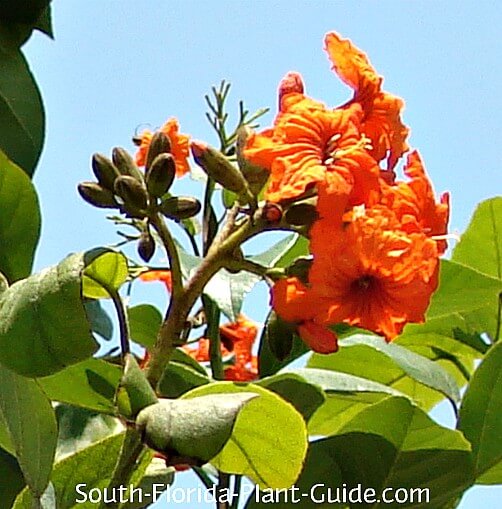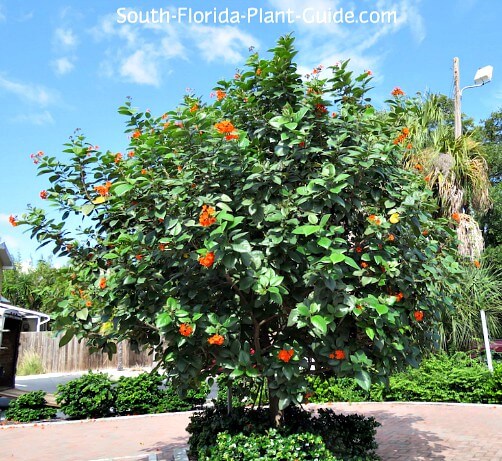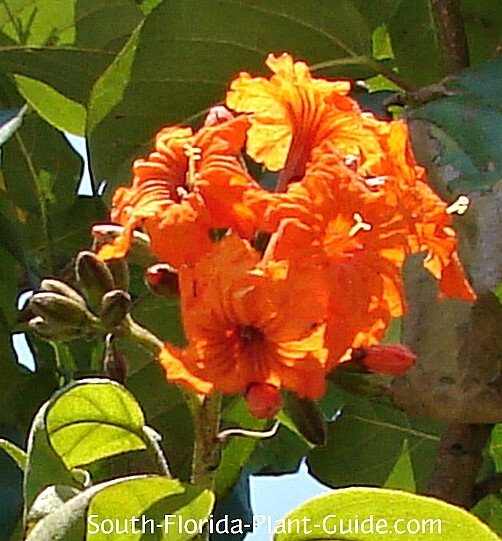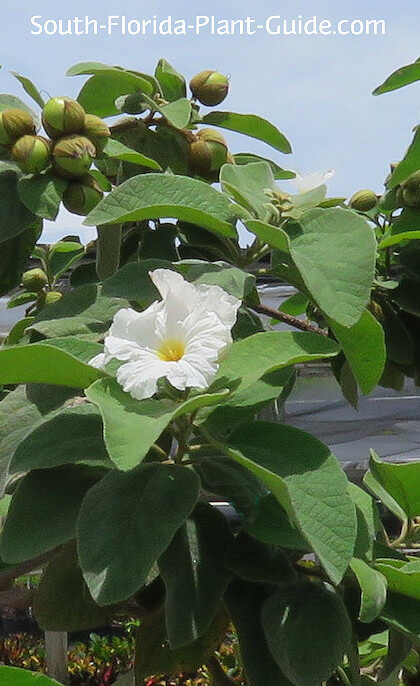Geiger Tree
Cordia spp.
Believed to be a native of the Florida Keys, the lovely geiger tree blooms during warm weather with frilly flower clusters in vivid orange, yellow or white.

The orange geiger (Cordia sebestena) is the most well-known, with showy, deep orange flowers that contrast nicely against the tree's coarse green leaves. Many consider it the most beautiful of Florida native trees.
Actually, no one knows for sure if the geiger is a Florida native or if it was introduced long ago from Cuba or elsewhere.
It was named in the 1830's by John James Audubon (of bird painting fame) after John Geiger (a harbor pilot who salvaged sunken treasure off the coast of Key West) with whom Audubon stayed and painted.
Geiger's Key West home, which featured a beautiful geiger tree in the front yard, later became Audubon House and Tropical Gardens.
There's even a small island (Geiger Key) named after it.

Whether you choose the orange, white (Cordia boissieri) or yellow-flowering geiger (Cordia lutea), these trees will put on a glorious show of color and work in just about any size yard.
The orange variety is a hummingbird attracter.
The geiger is low-maintenance as long as it's planted in a frost-free area sheltered from winter winds.
Its high salt tolerance makes it a perfect small flowering tree for homes on or near the beach.
Plant specs
A geiger tree grows at a moderate pace to 15 to 20 feet - the white geiger only gets about 10 to 15 feet.
It prefers a full to partial sun location, though it will grow in part shade.
These trees can grow as multi-trunk specimens, but it's best to buy a single-trunk tree so it will grow stronger.
Geigers don't like the cold. If the area where you live gets frost, don't plant a geiger tree. Frost can damage and even kill it - established ones might stand a chance of recovery but young trees will die.
They do best in Zone 10B, or warmer regions of Zone 10A, especially if placed in an area out of the wind. They're evergreen but temps below 40 degrees may cause some leaf drop.
Geigers are drought-tolerant once established, as well as salt-tolerant.

Plant care
No soil amendments are needed for this tree. Water regularly after planting, and during dry spells once it's established.
Cut it back in spring (late March or early April) to keep it the size you want, and trim branch ends anytime during warm weather to promote bushiness.
Fertilize three times a year - once each in spring, summer and autumn - with a good quality granular fertilizer. Supplement feedings with bone meal to promote heavy bloom.

Plant spacing
The geiger tree should be placed no closer than 10 feet from the house to let the crown fill out nicely.
If you're planting a row of these trees, space them 6 to 8 feet apart.
Geigers will work in containers or planters while young.
Landscape uses for the geiger tree
- accent tree for the corner of the house
- as a focal point near the entry
- specimen tree for the yard
GOOD SNOWBIRD PLANT? MAYBE - in warmer areas and with irrigation during dry weather
COMPANION PLANT SUGGESTIONS: The geiger prefers growing without turfgrass around its base, so avoid underplanting with groundcovers as well. Nearby shrubs such as croton, bush allamanda, cape tecoma honeysuckle and oleander will set off the tree's bright flower colors.
Other small flowering trees you might like: Frangipani Tree, Cassia Trees
Take a break!
The ultimate guide to low-maintenance plants
and landscaping!
An ebook by
Chase Landre
author of
South-Florida-Plant-Guide.com
Learn more!
Get a greener thumb!
Want to learn more about South Florida planting, watering, fertilizing and dealing with weeds and pests?
See our Gardening How-To section for answers!
Get instant curb appeal!
An ebook by
Chase Landre
author of
South-Florida-Plant-Guide.com
Learn how to get instant curb appeal with fast growing plants and landscaping techniques!


